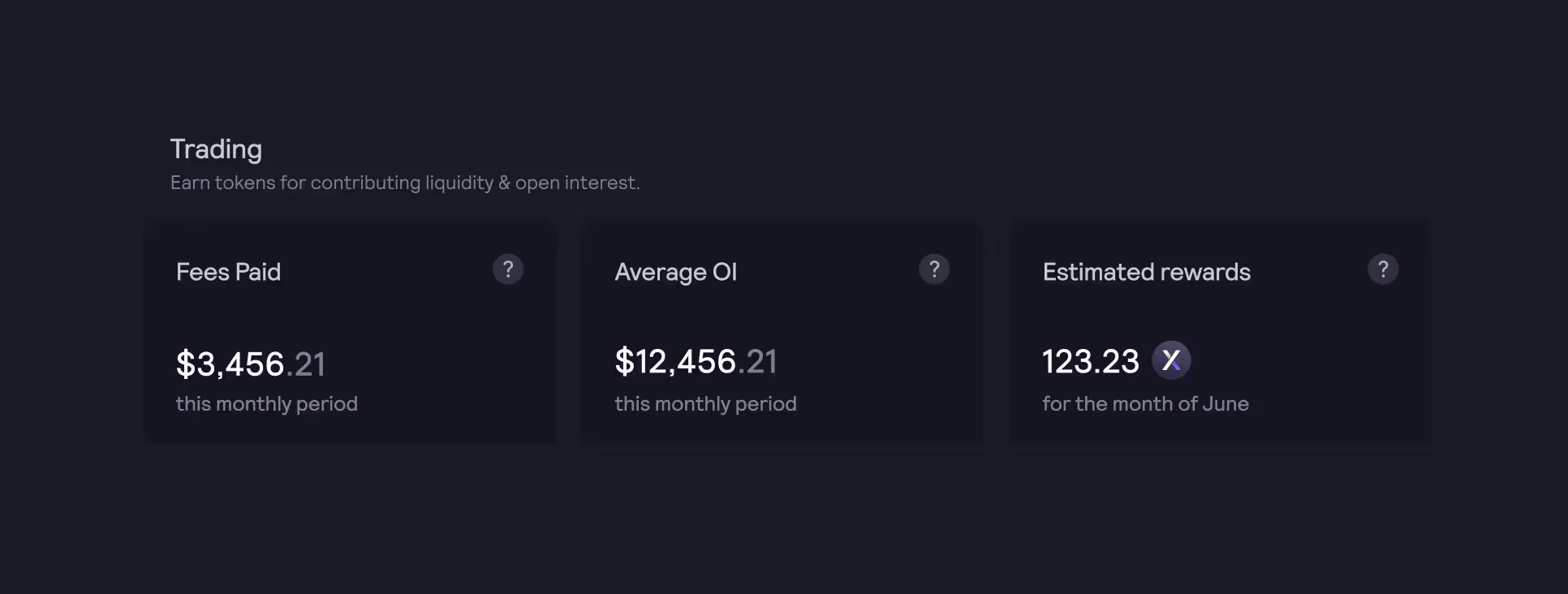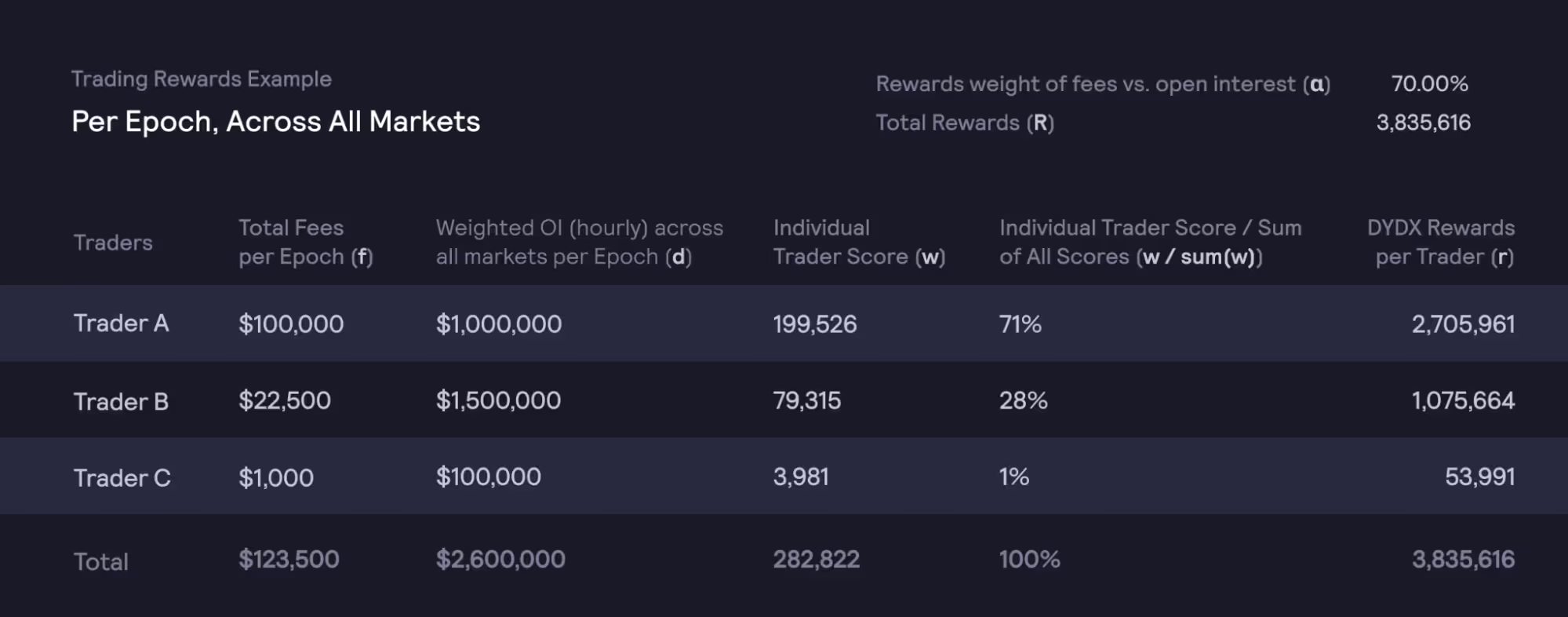
Token rewards programs, often referred to as liquidity mining, have proven to be a dramatically effective mechanism to drive growth to a Protocol. They are also the cornerstone of bootstrapping active and aligned community governance, by ensuring tokens are held by active users of the Protocol.
The challenge when designing token rewards programs is to ensure that the rewards incentivize real, valuable activity and growth on the Protocol that is non-gameable. By distributing rewards based on a multiplier of fees paid and open interest, traders must both actively trade (to incur fees) as well as hold positions to maximize rewards. Both of these are hard/expensive to game, and the function maximizes rewards for organic trading activity. Trading Rewards largely benefit takers who trade consistently on the platform while encouraging a healthy market structure.
How it Works
$$25%$$ of the supply of $DYDX ($$250M$$ $DYDX) has been allocated to the Trading Rewards program. Trading Rewards are distributed to traders based on a combination of fees paid and open interest on the dYdX Layer 2 perpetual protocol.
$$3,835,616$$ $DYDX will be distributed at the end of each epoch (28-days) over 5 years.
The Cobb-Douglas function says that output “Trader Score” is a weighted average of available factors fees (f) and open interest (d), and the weight of each factor is determined by parameter 0 < α < 1. At the end of an epoch, all Trader Scores are aggregated & rewards are proportionally distributed.

How are Weights Calculated
Let’s review the 4 major inputs of the Trading Rewards formula:
1/ Fees Paid
Fees paid is an important metric to measure trader activity.
Fees are determined by the 30-day volume-weighted maker-taker schedule. Fee discounts are provided for holding $DYDX.
The following table shows 30-day volume-weighted maker-taker fees:

Total fees paid are aggregated for each trader over the course of an epoch.
The following table shows hypothetical Trader Scores for users trading different volumes (assuming a constant average open interest of 1) and applying the fee schedule from above:

A few observations:
- Given that taker fees are higher than maker fees at all volume thresholds, taker volume is disproportionately rewarded.
- Makers trading above $50M in maker volume do not pay any fees and thus do not receive $DYDX rewards
2/ Average Open Interest
Open interest is the other important metric. Open interest is measured every minute (at a random time) across all markets and averaged across a given epoch.
The following table shows the hypothetical average open interest for Trader A, Trader B, and Trader C over the course of 40,320 minutes in an epoch:

A few observations:
- Trader A opens a 10 BTC position for 10 minutes. The weighted average Open Interest declines over the rest of the epoch.
- Trader B opens and closes a 1 BTC position within the same minute. No open interest is recorded for Trader B.
- Trader C opens a 1 BTC position in minute 6 and keeps the position open through the end of the epoch. While Trader C opened a small position, he has the highest weighted average Open Interest at the epoch.
Therefore, opening and holding open positions for longer is incentivized, while wash trading is disincentivized.
3/ Constant Weights
A constant weight of 0.7 is applied to the fees paid factor. A 1% increase in fees paid would lead to approximately a 0.7% increase in a user’s Trader Score.
A constant weight of 0.3 is applied to the Average Open Interest factor. A 1% increase in fees paid would lead to approximately a 0.3% increase in a user’s Trader Score.
The following chart shows the impact of different combinations of Fees Paid and Average Open Interest on a user’s Trader Score:

A few observations:
- While both Fees Paid and Average Open Interest are required in a given epoch to earn rewards, fees paid have a higher weight than average open interest.
- Traders are encouraged to trade from one account. Splitting trades into multiple accounts in a given epoch results in fewer rewards (e.g. (4^(0.3)2^(0.7) + 2^(0.3)4^(0.7)) < (6^(0.3)*6^(0.7)).
4/ Total Weight
Throughout the epoch, traders can see their estimated Trading Rewards here. These are only estimates as the Total Weight changes throughout the epoch as other traders pay more fees and open new positions.

At the end of an epoch, all Trader Scores are aggregated & epoch rewards are proportionally distributed. At the end of the epoch, final rewards for the epoch are calculated and can be claimed 7 days after the end of the epoch.
The following table shows rewards for all traders in a given epoch:

Next Steps
- Read the documentation for more details on Trading Rewards
- Start trading now at https://trade.dydx.exchange/
- Check your users can see fees paid, average open interest, and estimated trading rewards at http://trade.dydx.exchange/portfolio/rewards
- Earned $DYDX can be claimed on September 8th through the governance dashboard at https://dydx.community
About the dYdX Foundation
Legitimacy and Disclaimer
Crypto-assets can be highly volatile and trading crypto-assets involves risk of loss, particularly when using leverage. Investment into crypto-assets may not be regulated and may not be adequate for retail investors. Do your own research and due diligence before engaging in any activity involving crypto-assets.
dYdX is a decentralised, disintermediated and permissionless protocol, and is not available in the U.S. or to U.S. persons as well as in other restricted jurisdictions. The dYdX Foundation does not operate or participate in the operation of any component of the dYdX Chain's infrastructure.
The dYdX Foundation’s purpose is to support the current implementation and any future implementations of the dYdX protocol and to foster community-driven growth in the dYdX ecosystem.
The dYdX Chain software (including dYdX Unlimited) is open-source software to be used or implemented by any party in accordance with the applicable license. At no time should the dYdX Chain and/or its software or related components (including dYdX Unlimited) be deemed to be a product or service provided or made available in any way by the dYdX Foundation. Interactions with the dYdX Chain software (including dYdX Unlimited) or any implementation thereof are permissionless and disintermediated, subject to the terms of the applicable licenses and code. Users who interact with the dYdX Chain software, i ncluding dYdX Unlimited (or any implementations thereof) will not be interacting with the dYdX Foundation in any way whatsoever. The dYdX Foundation does not make any representations, warranties or covenants in connection with the dYdX Chain software (or any implementations and/or components thereof, including dYdX Unlimited), including (without limitation) with regard to their technical properties or performance, as well as their actual or potential usefulness or suitability for any particular purpose, and users agree to rely on the dYdX Chain software (or any implementations and/or components thereof, including dYdX Unlimited) “AS IS, WHERE IS”.
Nothing in this post should be used or considered as legal, financial, tax, or any other advice, nor as an instruction or invitation to act by anyone. Users should conduct their own research and due diligence before making any decisions. The dYdX Foundation may alter or update any information in this post in the future at its sole discretion and assumes no obligation to publicly disclose any such change. This post is solely based on the information available to the dYdX Foundation at the time it was published and should only be read and taken into consideration at the time it was published and on the basis of the circumstances that surrounded it. The dYdX Foundation makes no guarantees of future performance and is under no obligation to undertake any of the activities contemplated herein.
Depositing into the MegaVault carries risks. Do your own research and make sure to understand the risks before depositing funds. MegaVault returns are not guaranteed and may fluctuate over time depending on multiple factors. MegaVault returns may be negative and you may lose your entire investment.The dYdX Foundation does not operate or has control over the MegaVault and has not been involved in the development, deployment and operation of any component of the dYdX Unlimited software (including the MegaVault).
Get Involved with the Community
Become a part of our journey to reshape the financial landscape


